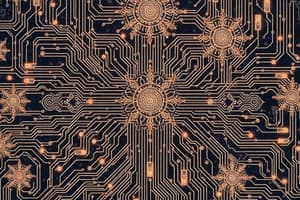Podcast
Questions and Answers
Quale afferma le decriptor de un circuit combinatorial?
Quale afferma le decriptor de un circuit combinatorial?
- Il reteme information in un modo temporar.
- Es non involve gates logicos.
- El produce un output basate sur le stato presentes. (correct)
- Supplementa uno signal de control.
Quale de le sequentes circuits es un tipico exemple de un latch?
Quale de le sequentes circuits es un tipico exemple de un latch?
- SR Latch (correct)
- Multiplexer
- D-Type Flip-Flop
- JK Flip-Flop
Quale es le function de un priority encoder?
Quale es le function de un priority encoder?
- Combine divers inputs in un singule output.
- Amplificar le signals de input.
- Transformar le signal analogic in un signal digital.
- Identificar le valore plus alte de input e produce un output correspondenti. (correct)
Quale subsection del design de circuits sequencials es directement connectete a tempore?
Quale subsection del design de circuits sequencials es directement connectete a tempore?
Quale es un aspect importante in le design de counters?
Quale es un aspect importante in le design de counters?
Which component is primarily responsible for converting binary data to decimal in combinational circuits?
Which component is primarily responsible for converting binary data to decimal in combinational circuits?
Which flip-flop type is known for toggling its output on a specific clock edge?
Which flip-flop type is known for toggling its output on a specific clock edge?
What is a primary characteristic of synchronous sequential circuits?
What is a primary characteristic of synchronous sequential circuits?
In designing a register, which parameter is crucial for determining its storage capacity?
In designing a register, which parameter is crucial for determining its storage capacity?
Which type of counter design allows both counting up and down?
Which type of counter design allows both counting up and down?
Flashcards
Adder
Adder
A digital circuit that performs addition of two binary numbers.
Latch
Latch
A circuit that stores one bit of data.
Flip-Flop
Flip-Flop
A type of latch that changes state only on a clock signal.
Sequential Circuit
Sequential Circuit
Signup and view all the flashcards
Register
Register
Signup and view all the flashcards
Combinational Circuit
Combinational Circuit
Signup and view all the flashcards
Decoder
Decoder
Signup and view all the flashcards
Encoder
Encoder
Signup and view all the flashcards
MUX (Multiplexer)
MUX (Multiplexer)
Signup and view all the flashcards
Study Notes
Combinational Circuits
- Adders: Circuits performing arithmetic addition.
- Decoders: Translate coded input signals into specific output signals.
- Encoders: Convert multiple input signals into a reduced set of output signals.
- Priority Encoders: Prioritize inputs when multiple inputs are active simultaneously.
- MUX (Multiplexer): Selects one input from multiple available inputs.
- Design of Combinational Circuits: Methods for creating digital circuits based on combinational logic.
Sequential Circuits
- Latches: Basic memory elements holding a single bit of data.
- Flip-Flops: More complex memory elements with sequential behavior.
- JK Flip-Flop (JKFF): A particular type of flip-flop with specific input characteristics.
- D Flip-Flop (DFF): A flip-flop where the input directly determines the output's value on the next clock cycle.
- T Flip-Flop (TFF): A flip-flop that changes state on each clock pulse.
- Excitation Tables: Tables defining the next state of a flip-flop based on its current state and inputs.
- Synchronous and Asynchronous Flip-Flops: Flip-flops categorized by how their inputs affect their output relative to a clock signal.
- Clocks: Provide timing signals controlling the sequence of operations in sequential digital circuits.
- State Table: A tabular representation of the states of a sequential circuit, their transitions, and outputs.
- State Diagram: A graphical representation of the states of a sequential circuit, transitions, and outputs.
- Timing Diagram: Visual representation of the timing relationships in sequential circuits showing clock signals and output changes relative to the clock cycles.
- Design of Sequential Circuits: Methods for crafting digital circuits with memory functions using sequential logic.
- Registers: Groups of flip-flops used for storing and manipulating binary data.
- Counters and their Design: Circuits counting events, and methods for designing such circuits.
Studying That Suits You
Use AI to generate personalized quizzes and flashcards to suit your learning preferences.





